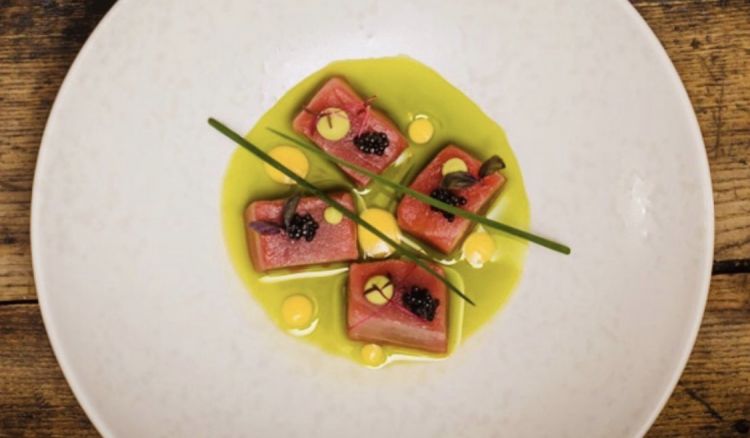When we arrived at Twist Kitchen, in Marylebone, we stopped for a moment, wondering whether this was the right place. We were expecting something modern, with dim lights, perhaps a monochromatic interior – instead, we were welcomed by an informal dining room, with red-brick walls, chairs with straw seats and granite tables, something more appropriate for a pizzeria than a fusion restaurant, let’s be honest. This is Twist Kitchen: fusion in every sense, both in the look and in the concept.
Eduardo Tuccillo is a true Campano, born on the Amalfi Coast and raised in Naples where he started his training at the local catering school; even though he left a long time ago, his southern pride is still there and is strongly anchored in his roots. He invited us to taste his dishes, which we appreciated because even though we feel we’re quite informed on the London culinary scene, we hadn’t heard of him yet. Our mistake, since the restaurant is packed, and even when we leave, which is late compared to local customs, there’s still lots of people.
The dining room is handed to his smiling wife Giulia, who guides us through the menu, which is divided in classic dishes, and tapas-style plates. The latter – Giulia says – offer the right way to appreciate Twist’s philosophy.

Red tuna ventresca, Sturia caviar, light miso broth

Aged beef, hispi cabbage, veal bone marrow jus
For sure, the menu is eclectic. Among other things, you can choose a 1kg cut of beef for two, cooked on the Josper grill, a platter of cheese and cured meat and a plate of Padron peppers. Among the tapas, instead, you can indeed find lots of creativity and a varied and interesting choice. Out of the ones we tasted, the scallops and red prawns from Mazara with pressed cucumber and a very delicate aroma of liquorice stood out. The octopus tentacle is well cooked, roasted and placed on a rich purée of black garlic and cabbage, and hidden by a translucid layer of Pata Negra lard. The Gnocchi with porcini butter and aged pecorino are delicious and satisfying.
Eduardo, when he finds a minute to say hallo, describes his cuisine passionately: a meeting of many different influences, from the native ones, of course, to those he acquired through his travels and the professional experiences that led him to arrive, five years ago, in this corner of Marylebone. Among others, he worked for Iaccarino, Ducasse, Adrià, from the Amalfi Coast to London via New York.
“I wanted to develop a menu that would show my career so far, and my constant exploration. I thought the tapas-format would be perfect to express myself because it offers lots of freedom” – Tuccillo says. With pride, he defines himself as a one-of-a-kind chef here in London, who makes food strongly influenced by the great minds of world experimental cuisine, but using authentic Italian ingredients; fresh, simple, always presented well and in an original way.
The choice of using these Italian ingredients is a proof of Eduardo’s desire to join flavours and traditions. The dishes we taste are all characterised by a light technique, capable of treating ingredients with expertise and delicateness. Eduardo quotes his grandmother and the kitchen in Naples were she fed 16 grandchildren as the sparkle that made him passionate about food – it seemed to him it looked more like a restaurant than a home, given the crowd of children sitting around the table.

Baby corn, toasted quinoa, shoyimi peppers and payoyo cheese

Pickled and raw vegetables from the kitchen garden, pomegranate, argan oil
With Twist, the chef somehow homages her and the memories of his origins. The tradition of Campania is strongly present, and it is in the dishes that recall this more clearly that – in our opinion – the skills of the chef stand out especially. The courgette flower filled with a fresh and excellent buffalo milk ricotta is fried impeccably, while the honey glazing offers an excellent contrast to the very aromatic background of lemons of Amalfi; for sure, this is the dish that stands out the most.
At Twist the aim is to preserve simplicity without too many manipulations. Perhaps this is the case but you can really notice the use of technique, for instance in the spheres of yogurt that burst in our palate in one of the daily specials: a gazpacho of beetroot served with crispy flakes of pastry, while the cream of avocado supports the fresh white spheres. Among the desserts, the coconut cheesecake with mango and black olive caramel is a direct link with one of the chefs with whom he has worked in the past (Jason Atherton).
That Eduardo Tuccillo is doing something good is proven by the acknowledgements he’s received and by the fact it’s been always full for the past 5 years (which is not always easy in London).
Translated into English by Slawka G. Scarso